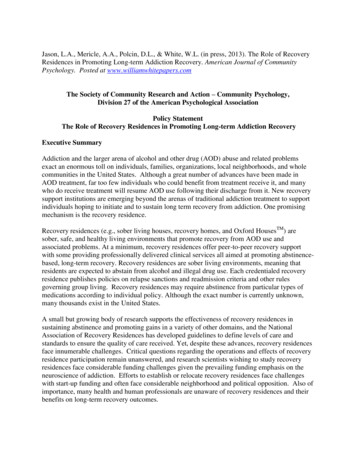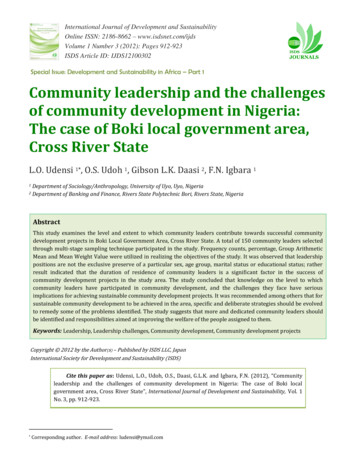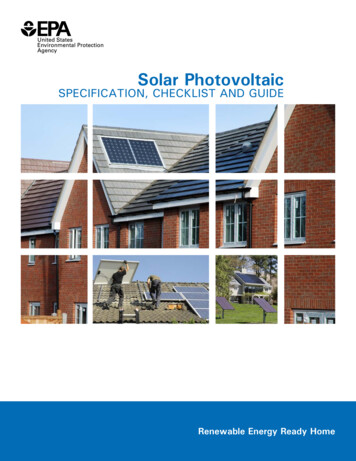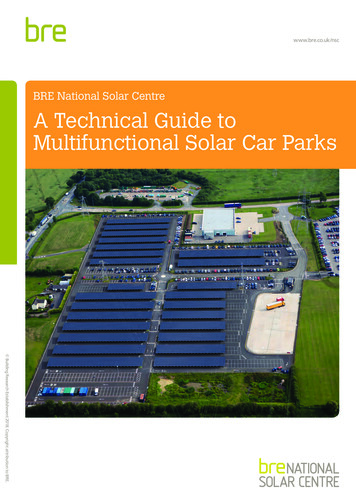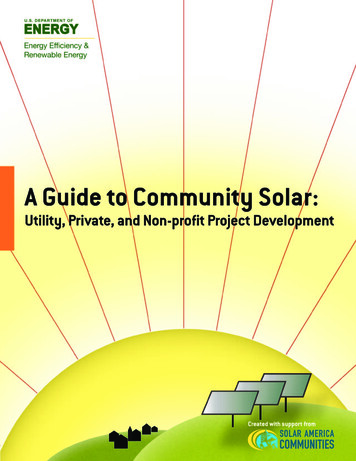
Transcription
ACKNOWLEDGEMENTSThe Community Solar Guide was developed for the National Renewable Energy Lab by Northwest SustainableEnergy for Economic Development, Keyes and Fox, Stoel Rives, and the Bonneville Environmental Foundation. ThisGuide builds on the research and writing from the Northwest Community Solar Guide, published by Bonneville Environmental Foundation and Northwest SEED.AUTHORSJason Coughlin, Jennifer Grove, Linda Irvine, Janet F.Jacobs, Sarah Johnson Phillips, Leslie Moynihan, JosephWiedmanREVIEWERS AND CONTRIBUTORSDick Wanderscheid, Bonneville EnvironmentalFoundation; Jessica Raker, Northwest SEED; RachelHuang, Sacramento Municipal Utility District; DavidBrosch, University Park Community Solar, LLC; TomEichbaum, University Park Community Solar, LLC; JerryMarizza, United Power; Lauren Martindale, Clean EnergyCollectivecompleteness, or usefulness of any information,apparatus, product, or process disclosed, or representsthat its use would not infringe privately owned rights.Reference herein to any specific commercial product,process, or service by trade name, trademark,manufacturer, or otherwise does not necessarilyconstitute or imply its endorsement, recommendation,or favoring by the United States government or anyagency thereof. The views and opinions of authorsexpressed herein do not necessarily state or reflectthose of the United States government or any agencythereof.SPONSORSGRAPHIC DESIGNLynnae Burns, Bonneville Environmental FoundationAvailable online at: www.osti.gov/bridgePublished November 2010NOTICEThis report was prepared as an account of worksponsored by an agency of the United Statesgovernment. Neither the United States governmentnor any agency thereof, nor any of their employees,makes any warranty, express or implied, or assumesany legal liability or responsibility for the accuracy,This report was made possible through funding from theU.S. Department of Energy’s Solar America Communitiesprogram. To learn more, please visit:www.solaramericacommunities.energy.govThis document is not legal or tax advice or a legal opinion on specific facts or circumstances. The contents areintended for informational purposes only.The authors are solely responsible for errors and omissions.Prepared for NRELSubcontract No. AGJ-0-40314-01
TABLE OF CONTENTSSECTION 1: INTRODUCTIONPurposeHow To Use This GuideWhy “Community” Solar?Definition of Key Terms22223SECTION 2: COMMUNITY SOLAR PROJECT MODELSUtility-Sponsored ModelSpecial Purpose Entity (SPE) ModelsNon-Profit ModelSummary Chart of Benefit Allocations67121921SECTION 3: EMERGING STATE POLICIES TO SUPPORT COMMUNITY SOLARGroup BillingVirtual Net MeteringJoint Ownership22222324SECTION 4: TAX POLICIES AND INCENTIVESBusiness Energy Investment Tax Credit (“Commercial ITC”)U.S. Treasury Renewable Energy GrantTax Credit BondsFederal GrantsState and Local Tax ConsiderationsInteractions Among State and Federal Incentives26272728292930SECTION 5: SECURITIES COMPLIANCE32SECTION 6: GETTING STARTED34SECTION 7: RESOURCESOrganizations and InstitutionsPublications383839APPENDIX ABusiness Formation and Types: Special Project Entities for Community Solar ProjectsSummary Table of Business Types404045APPENDIX BIntroduction to IREC’s Community Renewable Model Program Rules4646
IntroductionPURPOSEIn communities across the United States, people are seeking alternatives to conventional energy sources.Whether they aim to increase energy independence, hedge against rising fuel costs, cut carbon emissions,or provide local jobs, they are looking to community-scale renewable energy projects for solutions.Advances in solar technology, an increase in federal and state tax incentives, and creative new financingmodels have made solar projects including community solar projects, more financially feasible.This guide is designed as a resource for those who want to develop community solar projects, fromcommunity organizers or solar energy advocates to government officials or utility managers. By exploringthe range of incentives and policies while providing examples of operational community solar projects,this guide will help communities to plan and implement successful local energy projects. In addition, byhighlighting some of the policy best practices, this guide suggests changes in the regulatory landscapethat could significantly boost community solar installations across the country.HOW TO USE THIS GUIDEThe information in this guide is organized around three sponsorship models: utility-sponsored projects,projects sponsored by special purpose entities – businesses formed for the purpose of producingcommunity solar power, and non-profit sponsored projects. The guide addresses issues common to allproject models, as well as issues unique to each model.The guide begins with examples of the three project sponsorship models, discussing the legal andfinancial implications of each model. This is followed by a discussion of some state policies thatencourage community solar – ways for multiple individuals to share in the benefits of a single solarinstallation. The guide then reviews some of the tax and financing issues that impact community solarprojects. While the guide cannot offer legal or tax advice, the authors hope to provide an outline of thelegal hurdles and pitfalls that every project organizer should consider. Finally, the “Getting Started” sectionprovides readers with practical tools and tips for planning their own project. The Appendices provide amore detailed comparison of business structures suitable for special purpose entities pursuing solarprojects and the Interstate Renewable Energy Council’s Model Community Renewables Program Rules.This guide cannot possibly describe all available incentives or cite all the examples of community solarefforts nationwide. To track the most recent developments, we refer the reader to resources in Section 7.WHY “COMMUNITY” SOLAR?For the purpose of this guide, Community Solar is defined as a solar-electric system that, through avoluntary program, provides power and/or financial benefit to, or is owned by, multiple communitymembers. Community Solar advocates are driven by the recognition that the on-site solar marketcomprises only one part of the total market for solar energy. A 2008 study by the National RenewableEnergy Laboratory found that only 22 to 27% of residential rooftop area is suitable for hosting an on-site2SECTION 1: INTRODUCTION
photovoltaic (PV) system after adjusting for structural, shading, or ownership issues.i Clearly, communityoptions are needed to expand access to solar power for renters, those with shaded roofs, and those whochoose not to install a residential system on their home for financial or other reasons. Fairness alsosupports expanding programs in ways that increase options for participation. As a group, ratepayers and/or taxpayers fund solar incentive programs. Accordingly, as a matter of equity, solar energy programsshould be designed in a manner that allows all contributors to participate.This guide focuses on projects designed to increase access to solar energy and to reduce up-front costsfor participants. The secondary goals met by many Community Solar projects include:4Improved economies of scale4Optimal project siting4Increased public understanding of solar energy4Generation of local jobs4Opportunity to test new models of marketing, project financing and service deliveryCreative mechanisms to foster greater deployment of solar energy projects are not limited to thosedescribed in this guide. Readers may be interested in investigating the following efforts that employ someelements of community solar:4Bulk purchasing efforts in Portland, OR (Solarize Portland!) and nationwide (1BOG)4Solar services co-ops such as Cooperative Community Energy, CA4Utility-owned distributed generation on customer rooftops, such as the Arizona Public ServiceCo mmunity Power ProjectDEFINITION OF KEY TERMSThe following terms are defined in the context of community solar.Renewable Energy Credits (RECs, carbon offsets, or green tags): A renewable energy facility producestwo distinct products. The first is electricity. The second is the package of environmental benefits resultingfrom not generating the same electricity– and emissions –from a conventional gas or coal-fired powerplant. These environmental benefits can be packaged into a REC and sold separately from the electricalpower. A REC represents the collective environmental benefits, such as avoided mercury, CO2 and otherenvironmentally harmful pollutants, as a result of generating one megawatt-hour (MWh) of renewableenergy.In most cases, RECs are sold on a per MWh basis. However, some project organizers choose to sell allfuture rights to RECs up front, on a per installed watt basis, effectively capturing an installation rebate andforgoing any future revenue from REC sales.Net metering: Most on-site renewable energy systems use net metering to account for the value of theelectricity produced when production is greater than demand. Net-metering allows customers to bankthis excess electric generation on the grid, usually in the form of kilowatt-hour (kWh) credits that can beused as needed during a given period. Essentially, whenever the customer’s system is producing moreenergy than the customer is consuming, the excess energy flows to the grid and the customer’s meterSECTION 1: INTRODUCTION3
runs backwards. Because this “netting of energy” results in the customer purchasing fewer kWhs fromthe utility, the electricity produced from the renewable energy system can be valued at the retail price ofpower. Most utilities have a size limit for net metering. Community Solar project organizers should be sureto check before assuming participants in a community solar system can net-meter. It may be that somealternative arrangement, such as group billing or joint ownership, is used to account for the value of theelectricity produced by a community solar project.Tax appetite: Individuals and businesses can reduce the amount of taxes owed by using tax credits. Fora tax credit to have any value, though, the individual or business must actually owe taxes. If they are taxexempt or merely lacking sufficient income to need tax relief, the tax credits have no value. Individualsor businesses that can use tax credits to reduce the amount they owe in taxes are said to have a “taxappetite.” For example, public and non-profit organizations are tax-exempt and therefore do not have a taxappetite. In addition, tax-paying entities might be eligible to use tax-based incentives, but have insufficienttax appetite to make full use of them.Investment Tax Credit (ITC): Section 48 of the Internal Revenue Code defines the federal ITC. The ITCallows commercial, industrial, and utility owners of photovoltaic (PV) systems to take a one-time tax creditequivalent to 30% of qualified installed costs. There is also a federal residential renewable energy taxcredit (Internal Revenue Code Section 25D) but the residential tax credit requires that the PV system beinstalled on a home the taxpayer owns and uses as a residence, thus it would rarely, if ever, be applicableto community solar projects.Power purchase agreement (PPA): A PPA is an agreement between a wholesale energy producer and autility under which the utility agrees to purchase power. The PPA includes details such as the rates paidfor electricity and the time period during which it will be purchased. Sometimes, the term PPA or “3rd PartyPPA” is used to describe the agreement between the system owner and the on-site system host, underwhich the host purchases power from the system. This arrangement is not explicitly allowed in all states;in some states it may subject the system owner to regulation as a utility. To avoid confusion, in this guide,a PPA refers only to an agreement by a utility to purchase power from the solar system owner.Solar services agreement (SSA): A solar services agreement is an agreement between the system ownerand the system site host, for the provision of solar power and associated services. The system ownerdesigns, installs, and maintains the system (a set of solar services) and signs an agreement with the hostto continue to provide maintenance and solar power. The agreement is sometimes referred to as a PPA,but in this guide, we use the term SSA to indicate that the agreement between the system owner and thesystem site host is more than a power purchase: it is an agreement that the system owner will providespecific services to ensure continued solar power.Securities: A security is an investment instrument issued by a corporation, government, or otherorganization that offers evidence of debt or equity. Any transaction that involves an investment of moneyin an enterprise, with an expectation of profits to be earned through the efforts of someone other thanthe investor, is a transaction involving a security. Community solar organizers must take care to complywith both state and federal securities regulations, and preferably, to steer clear of inadvertently offering asecurity. (Further information on securities is provided in Section 4, Tax Policies and Incentives.)4SECTION 1: INTRODUCTION
United Power’s Sol Partners Installation, ColoradoSECTION 1: INTRODUCTION5
Community Solar Project ModelsPeople have many reasons for organizing or participating in a community solar project. Just as theirmotives vary, so do the possible project models, each with a unique set of costs, benefits, responsibilities,and rewards. This section reviews several project models:4Utility-Sponsored Model, in which a utility owns or operates a project that is open to voluntary ratepayerparticipation.4Special Purpose Entity (SPE) Model, in which individual investors join in a business enterprise todevelop a community solar project.4Non-Profit “Buy a Brick” Model, in which donors contribute to a community installation owned by acharitable non-profit corporation.The authors of this gu
Net metering: Most on-site renewable energy systems use net metering to account for the value of the electricity produced when production is greater than demand. Net-metering allows customers to bank this excess electric generation on the grid, usually in the form of kilowatt-hour (kWh) credits that can be used as needed during a given period .



